Happy summer everyone! I’m so excited to be back with some delicious new farm-to-table recipes for you. This season, I’m going to be taking you into the gardens and kitchens of some incredibly inspiring food producers who have some tasty recipes to share, as well as words of wisdom about what it means to them to grow great food.
My first video episode of the season features Vic Ladd-deGraff who operates Grindstone Farm, a diversified organic farm in Pulaski, New York, alongside her husband and son. When Vic told me about her beloved recipe for Asparagus Vinaigrette, I knew it needed to be featured in a video. It’s my kind of recipe: simple, easy to make, and oh so flavorful, allowing the main ingredient to shine front and center!
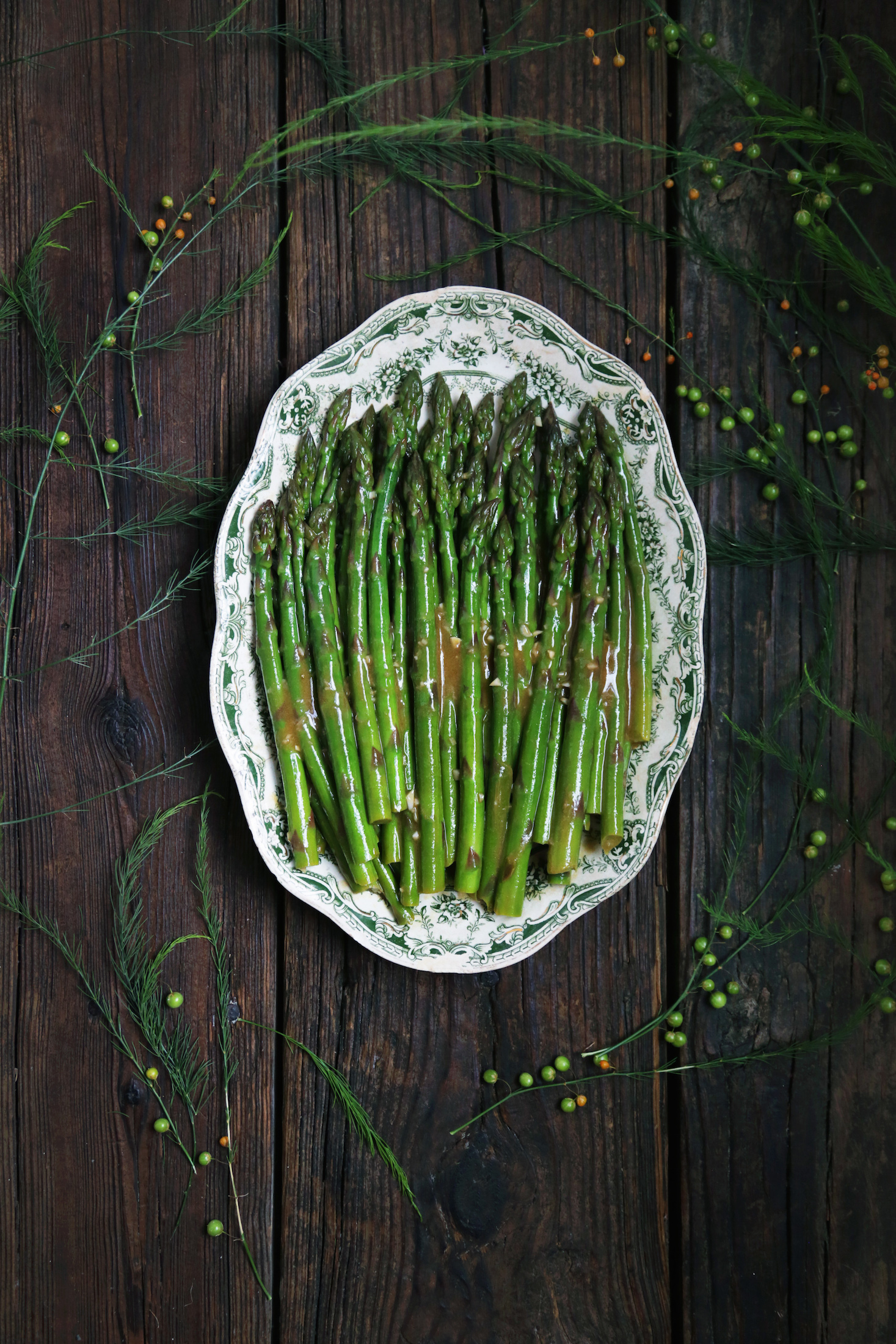
Vic has been making this recipe for 40 years and as she says in the video, when people taste this dish, they will think you’re a professional chef. Yup. It’s that good!!
Asparagus are a magical vegetable to harvest. Their sturdy spears come up out of the ground year after year once they’re established. But as Vic explained to me, if you want to grow asparagus in your garden, the very first thing you’ll need is PATIENCE! That’s because the asparagus crowns (basically small clumps of roots) take about 3 years before they start producing full-size asparagus. But it’s so worth the long wait. I just planted some crowns in my own garden this spring for a beautiful dark purple asparagus variety. So I’m putting my own patience to the test, but in the meantime, I’m so grateful for farmers like Vic who are growing such gorgeous organic asparagus.
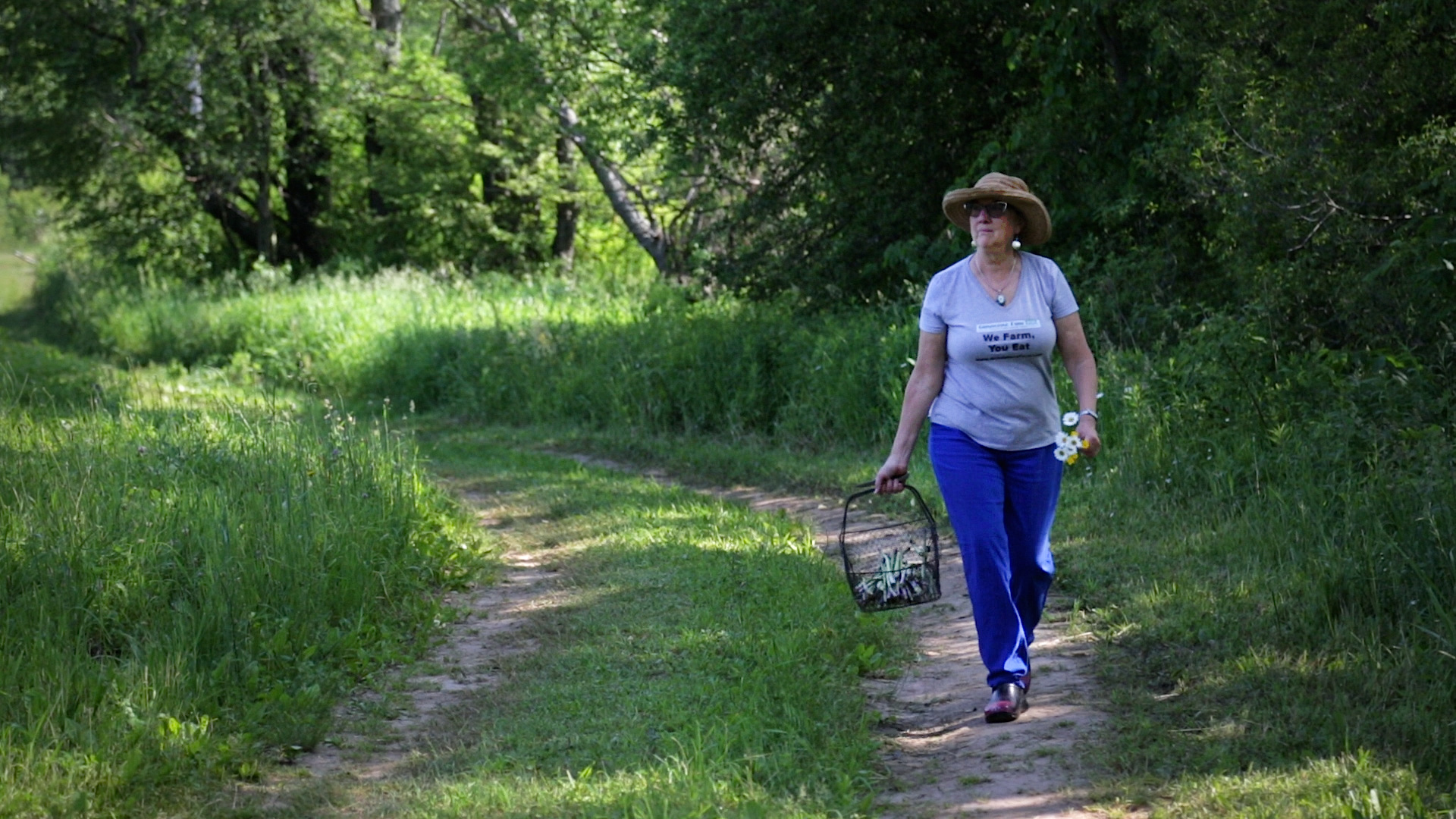
I was surprised to see Vic’s asparagus growing robustly right through mowed grass and weeds. Vic explained to me that because they farm organically, they don’t use pesticides to control weeds and pests, which means they have to find other ways to do it. One of the ways they work with the weeds is simply to mow down the field regularly so that the asparagus can emerge through the short weeds and grasses and get a strong growing start, with access to all the sunlight they need to quickly grow tall and sturdy. It’s amazing how hardy asparagus is and that its spears come right up through ground that is so richly carpeted with other plants. Another interesting organic technique Vic described for dealing with pests such as asparagus beetles, is that at the end of their season, once all the asparagus has been harvested, they fence off the asparagus field and release their poultry onto the field. The chickens, geese, and turkeys peck away and enthusiastically gobble up the asparagus beetles, leaving behind their manure to fertilize the field and keeping the asparagus beetle population in check. The beetles are a good protein source for the birds, so it’s a win-win situation and one of the many ways organic farming works in harmony with nature.
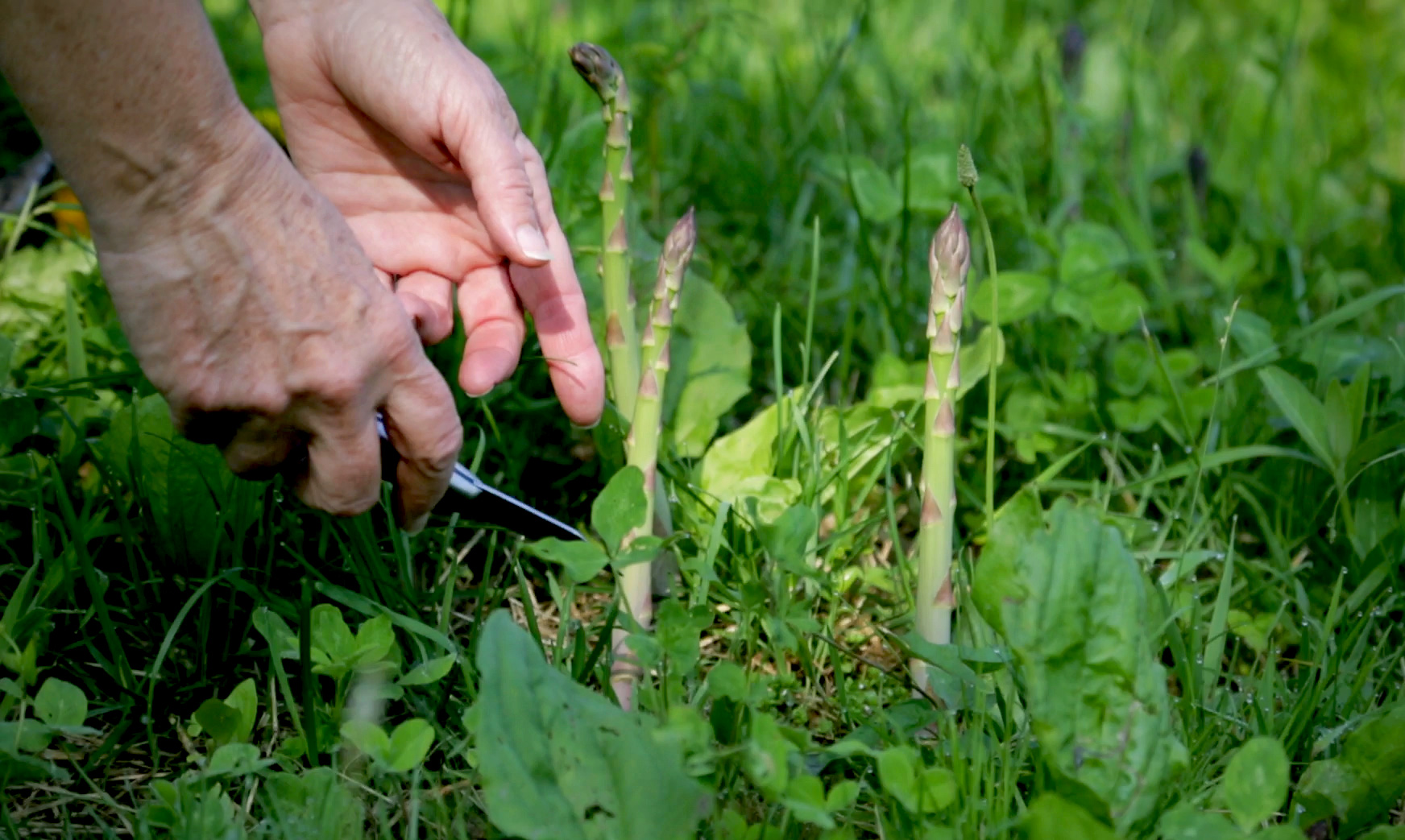
Asparagus is an important crop at Grindstone Farm and for many farmers, because it comes up in the spring, when there aren’t many other crops ready for harvest. So it’s an important source of income for the farm, at a time of year when there is not a lot of other income, but when the farm faces a large amount of expenses including seeds and new equipment.
Asparagus is a great source of fiber, folate, vitamins A, C, E and K, and chromium, which is a trace mineral that helps maintain healthy blood sugar levels. But I eat it because it’s so insanely delicious. I generally don’t buy asparagus off-season. Meaning, yes, I stubbornly wait a whole year, and then for a few months in the spring and early summer, when it’s locally available and fresh as can be, I devour it like a crazy person and eat it every chance I get!
I came home from filming at Vic’s farm, armed with 3 giant bundles of fresh organic asparagus as well as a take-away container full of the finished asparagus vinaigrette, which Vic had thoughtfully packed up for me. Even though I had just eaten a whole plate of asparagus in her kitchen, I ended up eating what was in the take-away container on a pit stop halfway home. I couldn’t resist, even though it meant there would be none left for my partner to taste. So I had to make the recipe for him. And then make it again, and again. Because it’s SO good! We can’t get enough of it. It’s one of those classic recipes that everyone should have in their repertoire, it will accompany pretty much any main dish, and it’s a perfectly suitable meal on its own, with a hard-boiled egg and a slice of crusty bread. Let me know how you like it in the comments below and bon appétit!
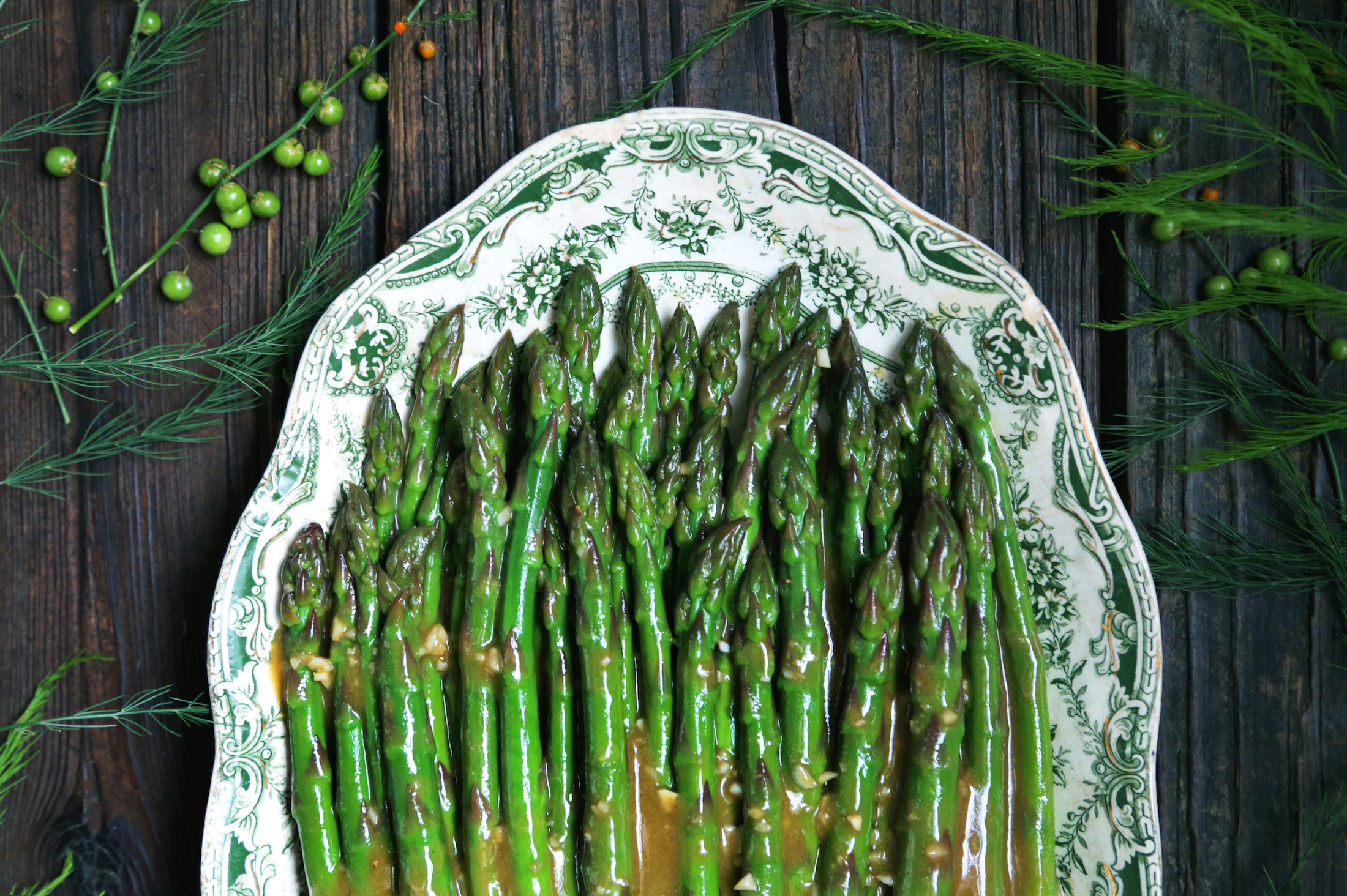
Vic’s Asparagus Vinaigrette
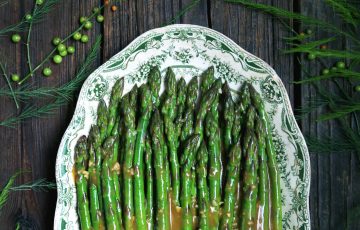
This simple, easy to make, and oh so flavorful recipe puts the brilliance of asparagus front and center. Read more about Aube Giroux's time with Vic Kitchen Vignettes.
- 2 bunches of asparagus
- 1/4 cup tarragon vinegar (Vic uses balsamic, so feel free to switch it up)
- 2 tablespoons Dijon mustard
- 2-3 cloves garlic, finely minced
- 1/2 cup olive oil
- Freshly ground pepper to taste
Ingredients
- Prepare the asparagus: Rinse the asparagus well. Snap off the bottom ends. When you apply pressure, the stem will snap in exactly the right spot, leaving you with a tender spear all the way through, and woody ends to discard of. Steam the asparagus in about one inch of water, covered in a lidded pan, for 4 minutes. While the asparagus is steaming, prepare an ice bath (a large bowl full of water and some ice cubes). At the 4 minute mark, pierce the asparagus with a fork to ensure they’re ready (fork should pierce through easily but the asparagus should remain bright green and should be “tender-crisp”). If you’ve overcooked the asparagus, it will turn a dull green and be mushy. (In this case, Vic says make soup with it instead). Immediately remove the asparagus once they’ve cooked, drain the water, and plunge them into the ice bath to stop cooking and maintain their vibrant green color. A minute or two in the ice bath should be plenty. Drain the asparagus and gently pat dry with a clean towel.
- Prepare the vinaigrette: Whisk all the ingredients together, except the oil. Slowly, pour in the oil, while whisking, so that it thickens the mixture. Taste and add pepper if needed.
- Assemble: Place the asparagus in the vinaigrette and stir gently, covering all the spears in the sauce. Cover and allow to sit in the fridge for a few hours to let the flavor of the vinaigrette soak in. Serve cold, as a side dish or as a main with crusty bread and optional toppings such as crumbled feta or chopped hard-boiled eggs. Enjoy!
Directions
Yield: Serves about 4 as a side dish
 Aube Giroux is a food writer and filmmaker who shares her love of cooking on her farm-to-table blog, Kitchen Vignettes.
Aube Giroux is a food writer and filmmaker who shares her love of cooking on her farm-to-table blog, Kitchen Vignettes.
Aube is a passionate organic gardener and home cook who likes to share the stories of how food gets to our dinner plates. Her work has been shown on television and at international film festivals. Her web series has been nominated for multiple James Beard Awards for Best Video Webcast (On Location). In 2012, she was the recipient of Saveur Magazine’s Best Food Blog award in the video category.

